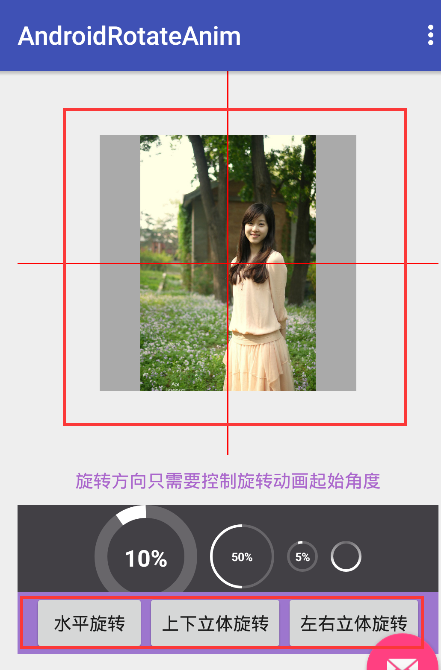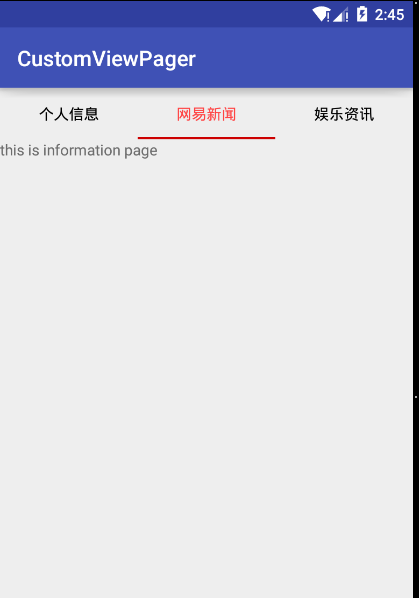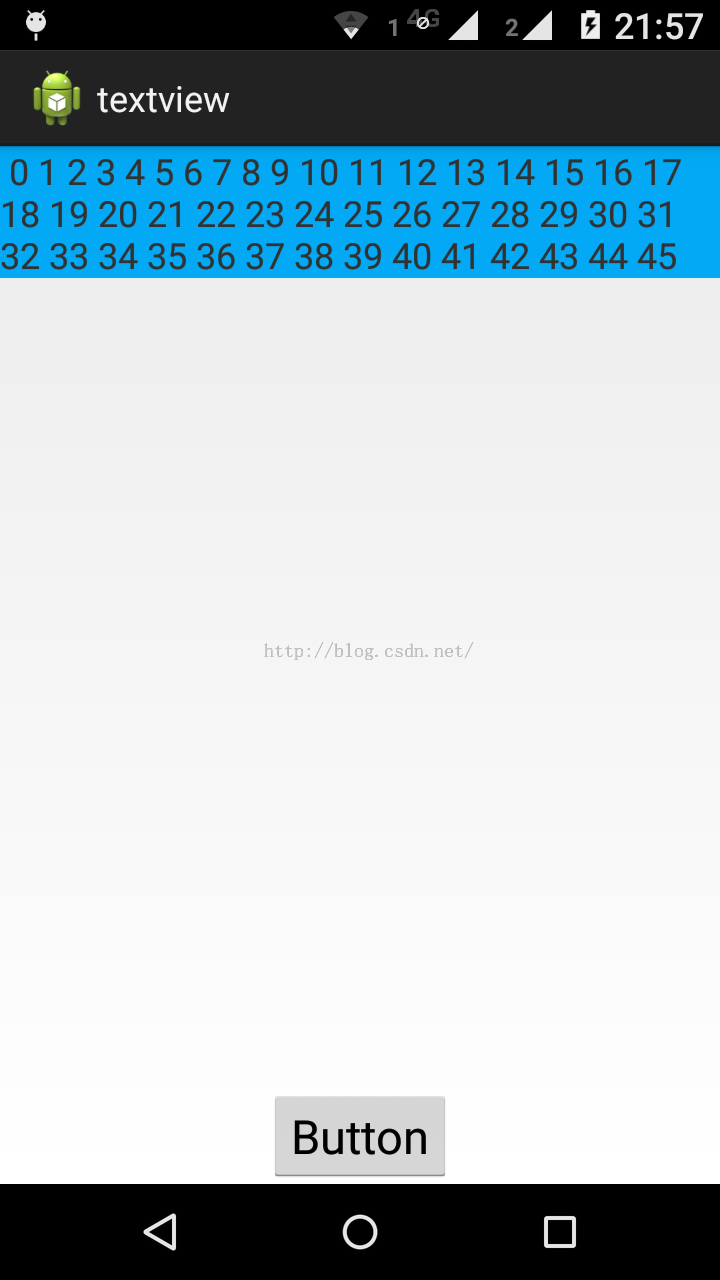編輯:關於android開發
本文主要介紹Android立體旋轉動畫,或者3D旋轉,下圖是我自己實現的一個界面

立體旋轉分為以下三種:
1. 以X軸為軸心旋轉
2. 以Y軸為軸心旋轉
3. 以Z軸為軸心旋轉--這種等價於android默認自帶的旋轉動畫RotateAnimation
實現立體旋轉核心步驟:
1. 繼承系統Animation重寫applyTransformation方法
通過applyTransformation方法的回調參數 float interpolatedTime, Transformation t 來控制旋轉動畫
interpolatedTime 用來計算旋轉角度而 t 用來控制變換矩陣從而實現圖像的旋轉
2. android.graphics.Camera控制旋轉算法
Camera可以對圖像執行一些比較復雜的操作--旋轉,綻放,與Matrix一起實現圖像的傾斜
核心代碼封裝:Rotate3dAnimation
package rotateanim.example.com.androidrotateanim;
import android.view.animation.Animation;
import android.view.animation.Transformation;
import android.graphics.Camera;
import android.graphics.Matrix;
/**
* An animation that rotates the view on the X,Y,Z axis between two specified angles.
* This animation also adds a translation on the Z axis (depth) to improve the effect.
*/
public class Rotate3dAnimation extends Animation {
public static final Byte ROTATE_X_AXIS = 0x00;
public static final Byte ROTATE_Y_AXIS = 0x01;
public static final Byte ROTATE_Z_AXIS = 0x02;
private final float mFromDegrees;
private final float mToDegrees;
private final float mCenterX;
private final float mCenterY;
private final float mDepthZ;
private final boolean mReverse;
private Camera mCamera;
private Byte mRotateAxis; // 0:X軸 1:Y軸 2:Z軸
/**創建3D旋轉動畫
* @param fromDegrees the start angle of the 3D rotation
* @param toDegrees the end angle of the 3D rotation
* @param centerX the X center of the 3D rotation
* @param centerY the Y center of the 3D rotation
* @param depthZ the Z depth of the 3D rotation
* @param rotateAxis the rotate axis of the 3D rotation
* @param reverse true if the translation should be reversed, false otherwise
*/
public Rotate3dAnimation(float fromDegrees, float toDegrees,
float centerX, float centerY, float depthZ, Byte rotateAxis, boolean reverse) {
mFromDegrees = fromDegrees;
mToDegrees = toDegrees;
mCenterX = centerX;
mCenterY = centerY;
mDepthZ = depthZ;
mRotateAxis = rotateAxis;
mReverse = reverse;
}
@Override
public void initialize(int width, int height, int parentWidth, int parentHeight) {
super.initialize(width, height, parentWidth, parentHeight);
mCamera = new Camera();
}
@Override
protected void applyTransformation(float interpolatedTime, Transformation t) {
final float fromDegrees = mFromDegrees;
float degrees = fromDegrees + ((mToDegrees - fromDegrees) * interpolatedTime);
final float centerX = mCenterX;
final float centerY = mCenterY;
final Camera camera = mCamera;
final Matrix matrix = t.getMatrix();
// 將當前的攝像頭位置保存下來,以便變換進行完成後恢復成原位
camera.save();
if (mReverse) {
// z的偏移會越來越大。這就會形成這樣一個效果,view從近到遠
camera.translate(0.0f, 0.0f, mDepthZ * interpolatedTime);
} else {
// z的偏移會越來越小。這就會形成這樣一個效果,我們的View從一個很遠的地方向我們移過來,越來越近,最終移到了我們的窗口上面
camera.translate(0.0f, 0.0f, mDepthZ * (1.0f - interpolatedTime));
}
// 是給我們的View加上旋轉效果,在移動的過程中,視圖還會以XYZ軸為中心進行旋轉。
if (ROTATE_X_AXIS.equals(mRotateAxis)) {
camera.rotateX(degrees);
} else if (ROTATE_Y_AXIS.equals(mRotateAxis)) {
camera.rotateY(degrees);
} else {
camera.rotateZ(degrees);
}
// 這個是將我們剛才定義的一系列變換應用到變換矩陣上面,調用完這句之後,我們就可以將camera的位置恢復了,以便下一次再使用。
camera.getMatrix(matrix);
// camera位置恢復
camera.restore();
// 下面兩句是為了動畫是以View中心為旋轉點
matrix.preTranslate(-centerX, -centerY);
matrix.postTranslate(centerX, centerY);
}
}
Rotate3dAnimation使用:跟普通動畫使用沒區別,設置給一個View對象,啟動動畫就搞定
mRotateImgv就是需要旋轉的View對象
// 以X軸為軸心旋轉
private void rotateOnXCoordinate() {
float centerX = mRotateImgv.getWidth() / 2.0f;
float centerY = mRotateImgv.getHeight() / 2.0f;
float depthZ = 0f;
Rotate3dAnimation rotate3dAnimationX = new Rotate3dAnimation(0, 180, centerX, centerY, depthZ, Rotate3dAnimation.ROTATE_X_AXIS, true);
rotate3dAnimationX.setDuration(1000);
mRotateImgv.startAnimation(rotate3dAnimationX);
}
// 以X軸為軸心旋轉
private void rotateOnYCoordinate() {
float centerX = mRotateImgv.getWidth() / 2.0f;
float centerY = mRotateImgv.getHeight() / 2.0f;
float centerZ = 0f;
Rotate3dAnimation rotate3dAnimationX = new Rotate3dAnimation(0, 180, centerX, centerY, centerZ, Rotate3dAnimation.ROTATE_Y_AXIS, true);
rotate3dAnimationX.setDuration(1000);
mRotateImgv.startAnimation(rotate3dAnimationX);
}
// 以Z軸為軸心旋轉---等價於普通平面旋轉動畫
private void rotateAnimHorizon() {
float centerX = mRotateImgv.getWidth() / 2.0f;
float centerY = mRotateImgv.getHeight() / 2.0f;
float centerZ = 0f;
Rotate3dAnimation rotate3dAnimationX = new Rotate3dAnimation(180, 0, centerX, centerY, centerZ, Rotate3dAnimation.ROTATE_Z_AXIS, true);
rotate3dAnimationX.setDuration(1000);
mRotateImgv.startAnimation(rotate3dAnimationX);
// 下面是使用android自帶的旋轉動畫
// RotateAnimation rotateAnimation = new RotateAnimation(0, 180, Animation.RELATIVE_TO_SELF, 0.5f, Animation.RELATIVE_TO_SELF, 0.5f);
// rotateAnimation.setDuration(1000);
// mRotateImgv.startAnimation(rotateAnimation);
}
 安卓應用的界面編程(4),安卓界面編程
安卓應用的界面編程(4),安卓界面編程
安卓應用的界面編程(4),安卓界面編程第三組UI組件:ImageView及其子類 主要功能是顯示圖片,任何Drawable對象都可使用ImageView來顯
 Android開發Tips(2)
Android開發Tips(2)
Android開發Tips(2) 1. Dagger2的開發順序 Module -> Component -> Application 首先模塊(Modul
 TabLayout和ViewPager簡單實現頁卡的滑動,tablayoutviewpager
TabLayout和ViewPager簡單實現頁卡的滑動,tablayoutviewpager
TabLayout和ViewPager簡單實現頁卡的滑動,tablayoutviewpager首先需要在當前的module中的build Gradle的 dependen
 (轉)可收縮、擴展的TextView,擴展textview
(轉)可收縮、擴展的TextView,擴展textview
(轉)可收縮、擴展的TextView,擴展textview在一些應用中,比如騰訊的應用市場APP應用寶,關於某款應用的介紹文字,如果介紹文字過長,那麼不是全部展現出來,而